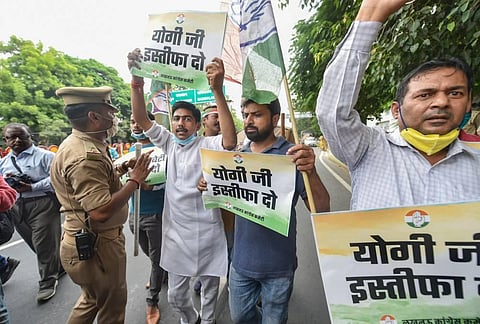

NEW DELHI: "Our child was raped and killed only because she was a Dalit. Our children have no safety here," said Ram Lal (name changed), the uncle of a 13-year-old girl who was raped and murdered in Uttar Pradesh's Lakhimpur Kheri in August.
As nationwide outrage poured over the Hathras incident in which a 19-year-old girl died of injuries from the gangrape and brutal physical torture, families of victims of atrocities feel it is still a long way to justice.
Experts observed dominant castes unleash violence on Dalits to wield power over them. It is also often linked with the social progress of Dalits, they said.
"It is painful for us to describe the state the girl was found in," said Lal.
The latest National Crime Records Bureau data show an increase of 7.3 per cent in crimes against scheduled caste people with 45,935 cases -- an increase from 42,793 cases registered in 2018.
Uttar Pradesh alone accounts for over 25 per cent of the total cases by recording the highest number of atrocities against SC people in the country.
The National Dalit Movement for Justice (NDMJ)-National Campaign of Dalit Human Rights (NCDHR) -- coalitions defending rights of Dalits -- said the recent rapes of Dalit girls in Lakhimpur Kheri, Hathras and Balrampur expose the existing situation of the lower caste in the country.
Vimal Thorat, academic and convener of NCDHR, pointed out the number of reported cases is an underestimation of the ground reality. There is a climate of hate against the marginalised in the country, she said.
"Are Dalits being tortured for being empowered? The accused feel they will have impunity," Thorat said.
Ram Dular, state coordinator, NDMJ-NCDHR, Uttar Pradesh said the grievous nature of the gangrapes expose the intersectional areas of caste and gender with Dalit women bearing the brunt of systemic violence perpetrated by people from the upper caste.
A recent study by Commonwealth Human Rights Initiative and Association for Advocacy and Legal Initiatives showed police took between two days to over seven months when it came to registering first information reports (FIRs) in rape cases in Uttar Pradesh.
Dalit women faced more hurdles in accessing the judiciary, the analysis showed.
The crime head-wise cases for atrocities committed against SCs in the 2019 data showed rape constituted 7.6 per cent of the total cases against them.
While 'simple hurt' at 28.9 per cent formed the largest chunk of cases of crimes against Dalits, it was followed by cases under SC/ST (Prevention of Atrocities) Act with 9 per cent cases.
"Anti-Dalit violence, including rape of Dalit women, is a manifestation of resentment among members of privileged castes who feel unsettled by the social progress among Dalits. Rape is often a weapon of control," said political economist Anoop Sadanandan.
Noting that there was an upsurge of violence against Dalits in the last decade, Sadanandan said it is often greater in states where the relative progress by Dalits has bridged the gap between the historic inter-caste differences, and helped them acquire what the traditionally privileged castes see as their entitlements-education, employment, and lifestyle.
"I lost my father to violence by upper caste people. The judiciary has failed us too," said 18-year-old Vinod from Lakhimpur Kheri.
"He was charred to death after a spat with people from the higher caste in March. This is how they show us our place," he said. Dalit activist Beena Pallical said a significant amount of the violence recorded is 'backlash violence'.
"As long as the mindset of discrimination and untouchability exist, violence will continue. The only way we can undo is by implementing the existing policies," said Pallical. Government data show over 25,000 cases of violence against Dalits were registered in 2000 and over 32,000 in 2010.
Between the years 2011 to 2013, the number of cases varied between over 33,000 to over 39,000. The year 2014 saw a sharp increase by recording 47,064 cases and 2015 witnessed 45,003 cases.
While 2016 recorded over 40,000 cases, there were 43,203 cases registered in 2017, according to the NCRB statistics.
Law has not been able to provide enough protection to Dalits with them often being victims of atrocities when they seek equal rights, observed former chairperson of University Grants Commission, and economist Sukhadeo Thorat. In the recent times, there has been a systemic boost given to the ideology of caste, he added.
"Those who seek to access the well prohibited for scheduled caste, take out a marriage procession through the main street of the village and are attacked. This indicates the high castes do not want to change the system," said the economist.
"Earlier there were atrocities between two persons -- between a SC and a person from higher caste. In the last decade, the nature of atrocities has changed. Now, there is mass violence -- which is a new phenomenon. This means that the caste consciousness is consolidated," he added.
An analysis by NDMJ showed a total of 62,195 cases of atrocities against SC remained pending for investigation at the end 2019, including previous year cases.
Dalit organisations have called for an immediate action plan from the government to stop violence against Dalits.